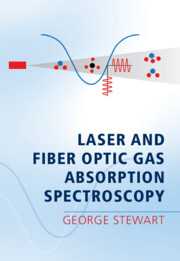Book contents
- Laser and Fiber Optic Gas Absorption Spectroscopy
- Laser and Fiber Optic Gas Absorption Spectroscopy
- Copyright page
- Dedication
- Contents
- Preface
- 1 Absorption Spectroscopy of Gases
- 2 DFB Lasers for Near-IR Spectroscopy
- 3 Wavelength Modulation Spectroscopy with DFB Lasers
- 4 Photoacoustic Spectroscopy with DFB Sources
- 5 Design and Application of DFB Laser Systems and Optical Fibre Networks for Near-IR Gas Spectroscopy
- 6 Principles of Fibre Amplifiers and Lasers for Near-IR Spectroscopy
- 7 Applications of Fibre Amplifiers and Lasers in Spectroscopy
- 8 Mid-IR Systems and the Future of Gas Absorption Spectroscopy
- Index
- References
6 - Principles of Fibre Amplifiers and Lasers for Near-IR Spectroscopy
Published online by Cambridge University Press: 07 April 2021
- Laser and Fiber Optic Gas Absorption Spectroscopy
- Laser and Fiber Optic Gas Absorption Spectroscopy
- Copyright page
- Dedication
- Contents
- Preface
- 1 Absorption Spectroscopy of Gases
- 2 DFB Lasers for Near-IR Spectroscopy
- 3 Wavelength Modulation Spectroscopy with DFB Lasers
- 4 Photoacoustic Spectroscopy with DFB Sources
- 5 Design and Application of DFB Laser Systems and Optical Fibre Networks for Near-IR Gas Spectroscopy
- 6 Principles of Fibre Amplifiers and Lasers for Near-IR Spectroscopy
- 7 Applications of Fibre Amplifiers and Lasers in Spectroscopy
- 8 Mid-IR Systems and the Future of Gas Absorption Spectroscopy
- Index
- References
Summary
The fundamental principles which govern the operation and define the characteristics of rare earth-doped fibre amplifiers and lasers are discussed in detail.The important role of phonon interactions with the Stark energy levels of the 4f electron orbitals is explained and the McCumber relationship for the absorption and emission cross-sections is derived. Atomic and cavity rate equations for fibre amplifiers and lasers are derived from first principles, including the contributions from spontaneous and amplified spontaneous emission. The rate equations are used to model fibre lasers under the various conditions of operation that relate to possible applications in near-IR gas spectroscopy, such as for tuneable or multi-wavelength sources, frequency combs and intra-cavity laser absorption spectroscopy.Examples are given of the theoretical laser output when operating under steady-state, multi-wavelength, transient or mode-locked regimes.The principles of stimulated Raman scattering are also discussed for accessing near-IR absorption lines at longer wavelengths by extending, through the Stokes shift, the available wavelength range of operation with fibre amplifiers or lasers.
Keywords
- Type
- Chapter
- Information
- Laser and Fiber Optic Gas Absorption Spectroscopy , pp. 159 - 197Publisher: Cambridge University PressPrint publication year: 2021



